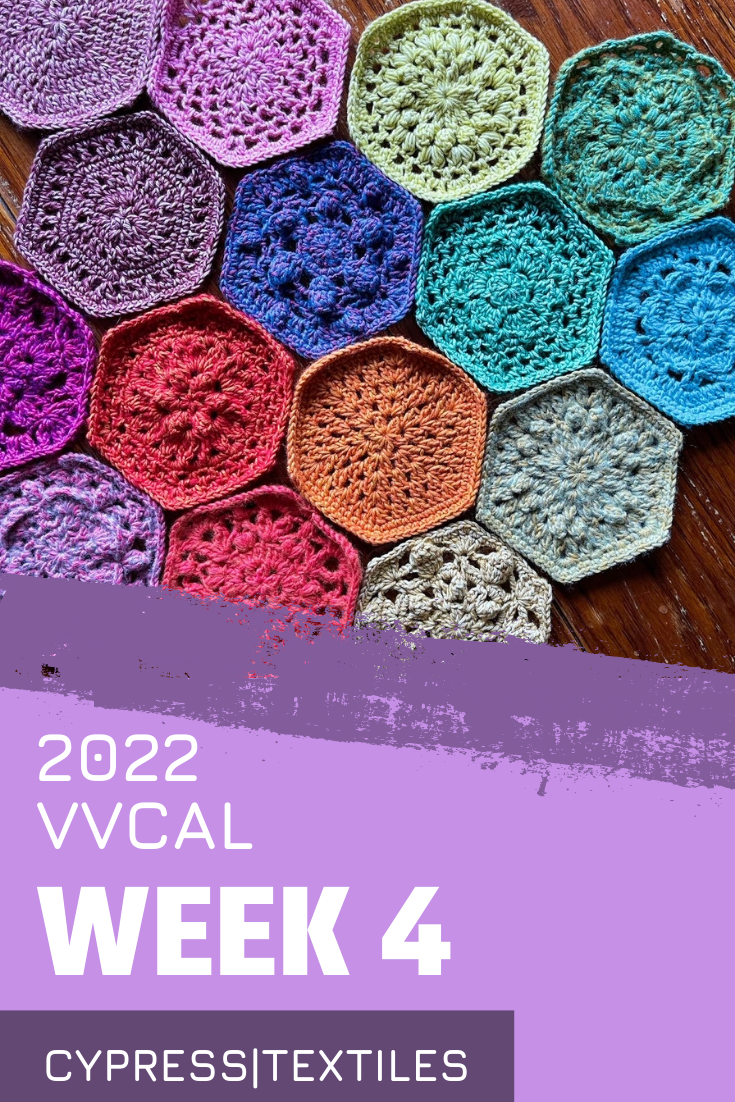Hello, and a huge welcome to Week 8 of the 2022 Vibrant Vintage Crochet-A-Long (VVCAL)! I can’t believe we are almost halfway! Remember on Week 11, the full pattern PDF will be released – on May, Friday the 13th!
Quick Links to Each Week: 1/2/3/4/5/6/7/8/9/10/11/12/13/14/15/16/17/18/19/20
What to Expect Today
- 3 blog posts: The Weekly Post with instructions for each blanket version (this post), plus 2 Cosmos Themed hexie designs
- Patterns include written instructions in US and UK Terms, chart, step-by-step photos, and YouTube video (US Terms).
Social Media Hashtags: #VVCAL and #CypressTextiles
2022 VVCAL Quick Links
- 2022 VVCAL Main Information Page
- 2022 VVCAL Tips and Tricks Page
- 2022 VVCAL Ravelry ebook Motifs link back to their blog posts. Favorite the hexagon, add it to your Ravelry queue, see others’ projects, and more!
- Vibrant Vintage CAL (Official) Facebook Group Post VVCAL WIP/FO pics, ask questions, post your FO pic of the previous years’ VVCAL blankets.
- CypressTextiles Tree Huggers Facebook Group – This is my main FB group (join!). Share your VVCAL progress pics in this group if you like, and I will share CAL highlights here, but the weekly action will be in the other group linked above.
- YouTube Channel (Subscribe!) – Here I will be posting CAL pattern videos weekly for the duration of the CAL.
Find your version below and get started!
Catona 10g Colour Pack version

Make 6 hexies total:
- 1 x Plain Hexie A in color 074
- 1 x Plain Hexie B in color 100
- 2 x Gliese in colors 101 and 106
- 2 x Saturn in colors 110 and 113
Gauge note: All hexies should be compared back to the Week 1 Plain Hexie A hexagon that you made throughout the CAL to maintain gauge.

1 Pack SW/RW 10g Colour Pack version

Make 4 hexies total:
- 1 x Plain Hexie A in color 820
- 1 x Plain Hexie B in color 804
- 1 x Gliese in color 814
- 1 x Saturn in color 953
Gauge note: All hexies should be compared back to the Week 1 Plain Hexie A hexagon that you made throughout the CAL to maintain gauge.

2 Packs SW/RW 10g Colour Pack version

Make 7 hexies total:
- 1 x Plain Hexie A in color 829
- 2 x Plain Hexie B in colors 805 and 808
- 2 x Gliese in colors 820 and 950
- 2 x Saturn in colors 823 and 826
Gauge note: All hexies should be compared back to the Week 1 Plain Hexie A hexagon that you made throughout the CAL to maintain gauge.

Metropolis 10g Colour Pack version
Photo coming soon!
Make 9 hexies total:
- 1 x Plain Hexie A in color 007
- 2 x Plain Hexie B in colors 006 and 001
- 3 x Gliese in colors 010, 003, and 006
- 3 x Saturn in colors 003, 010, and 001
Gauge note: All hexies should be compared back to the Week 1 Plain Hexie A hexagon that you made throughout the CAL to maintain gauge.

Colour Crafter stash version
Photo coming soon!
Colors are not given for this version because it is made with stash yarn in any desired palette.
Make 4 hexies total:
- 1 x Plain Hexie A
- 1 x Plain Hexie B
- 1 x Gliese
- 1 x Saturn
Gauge note: All hexies should be compared back to the Week 1 Plain Hexie A hexagon that you made throughout the CAL to maintain gauge. Note: Since this version does not use 10g balls, it doesn’t matter as much that your hexagons meet the spec below. As long as they are all the same size as your Plain Hexie A, you will be golden.

Chunky Monkey stash version
Photo coming soon!
Colors are not given for this version because it is made with stash yarn in any desired palette.
Make 2 hexies total:
Gauge note: All hexies should be compared back to the Week 1 Plain Hexie A hexagon that you made throughout the CAL to maintain gauge. Note: Since this version does not use 10g balls, it doesn’t matter as much that your hexagons meet the spec below. As long as they are all the same size as your Plain Hexie A, you will be golden.

Thank you so much for stopping in for this week of the 2022 VVCAL!
Happy Crafting,
Rachele C. – The Art of Crochet Blankets

2022 VVCAL Quick Links
- 2022 VVCAL Main Information Page
- 2022 VVCAL Tips and Tricks Page
- 2022 VVCAL Ravelry ebook Motifs link back to their blog posts. Favorite the hexagon, add it to your Ravelry queue, see others’ projects, and more!
- Vibrant Vintage CAL (Official) Facebook Group Post VVCAL WIP/FO pics, ask questions, post your FO pic of the previous years’ VVCAL blankets.
- CypressTextiles Tree Huggers Facebook Group – This is my main FB group (join!). Share your VVCAL progress pics in this group if you like, and I will share CAL highlights here, but the weekly action will be in the other group linked above.
- YouTube Channel (Subscribe!) – Here I will be posting CAL pattern videos weekly for the duration of the CAL.






















































































































































































































































































































































